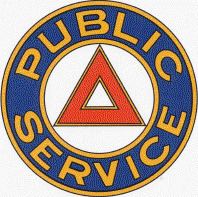 | ||
Transport of New Jersey (TNJ), earlier Public Service Transportation and then Public Service Coordinated Transport, was a street railway (after 1928) and bus company in the U.S. state of New Jersey from 1971 to 1980, when New Jersey Transit took over their operations. It was owned by the Public Service Corporation, now the Public Service Electric and Gas Company.
Public Service Transportation was formed in 1917 as a bus-operating subsidiary of the Public Service Corporation, supplementing the Public Service Railway's trolley lines. In 1928, the operations of the two companies were merged to form Public Service Coordinated Transport. The name was changed to Transport of New Jersey in 1971, and the new New Jersey Transit Corporation took over their operations in 1980.
Public Service Railway
The Public Service Railway, owned by the Public Service Corporation of New Jersey, operated most of the streetcar lines in New Jersey by the early 20th century. Public Service lines stretched from northeast New Jersey to Trenton, and then south to Camden and its suburbs. Major parts of the system were:
For many years, the only streetcar route still in operation was the #7 line, in the form of the Newark City Subway. The #7 at the turn of the 21st century underwent a line rehabilitation including new modern light rail cars, and was extended northward into Bloomfield. Additionally, a portion of an old NCS spur tunnel to the abandoned Cedar Street Subway (#13-Broad St., #27-Mt. Prospect, and #43-Jersey City), another Public Service trolley conduit, has been rehabilitated and opened for service in 2006 as another portion of the subway, to serve as a connection between Newark's two train stations and provide access to the Performing Arts Center, Newark Bears Stadium, Washington Park and the Newark Public Library. The other two light rail systems in New Jersey Hudson Bergen Light Rail and River Line are built along freight railroad rights-of-way and public streets, and do not date back to Public Service days.
In later years, Public Service bustituted most routes; many of these lines are still run by New Jersey Transit and even use the same number. In 1928 the operations were merged with Public Service Transportation, which operated these buses, into Public Service Coordinated Transport.
